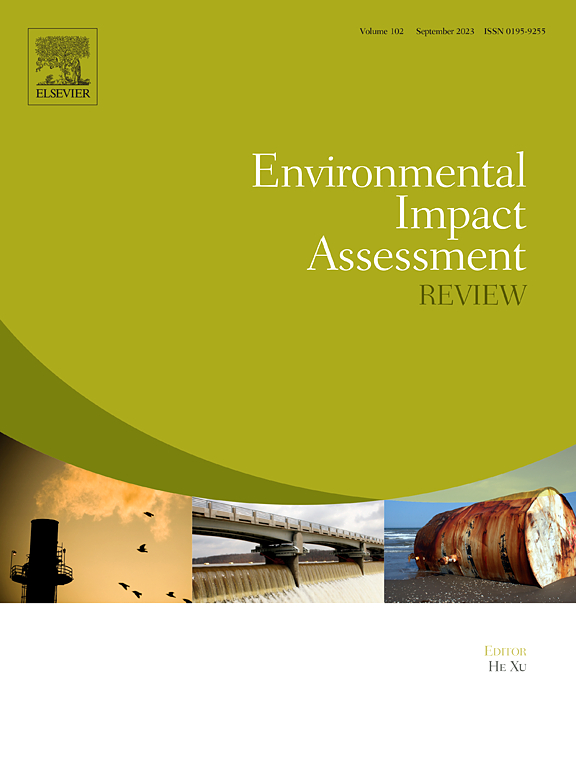通过特定配置生命周期评估揭示中国洗煤厂环境影响的异质性
IF 9.8
1区 社会学
Q1 ENVIRONMENTAL STUDIES
引用次数: 0
摘要
在中国,由于煤炭污染的末端治理潜力有限,洗煤被认为是缓解煤炭引发的空气污染的一种可行方法。然而,由于缺乏对洗煤的环境负担及其相关间接影响的全面研究,对洗煤效益的估计过于乐观。此外,由于洗煤厂使用的不同规模和技术对环境的影响尚未确定,因此无法有效解决下游各行业对煤炭数量和质量的具体要求。本研究旨在量化中国洗煤厂的直接和间接环境影响,并创新性地揭示其内部差异及其形成机制。本研究共调查了 2367 家洗煤厂,并对 20 种洗选规模与技术相结合的配置进行了分类。采用 ReCiPe 2016 方法对洗煤厂的输入和输出数据进行建模,以进行特定配置的生命周期评估。结果表明,在大多数情况下,扩大工厂规模可将环境效益提高 11.0-38.4%。与跳汰法相比,浮选法和重介质法洗煤由于使用了化学试剂和介质粉,对环境的影响一般较高,分别为2.0-16.0%和0.6-7.3%。各省不同的配置结构造成了空间上的环境影响差异,华南和华东地区的环境影响较大,而华北和西部地区的环境影响较小。结果凸显了煤炭生产和消费环节中隐藏的洗煤对环境的巨大影响。此外,研究结果还揭示了针对下游特定需求的空间明确配置策略,并表明加强固体废物利用可减少有毒环境影响。本文章由计算机程序翻译,如有差异,请以英文原文为准。

Unveiling the heterogeneity of environmental impacts of China's coal washing plants by a configuration-specific life cycle assessment
Coal washing is considered a promising method of mitigating coal-induced air pollution in China because of the limited end-of-pipe treatment potential for coal pollution. However, the estimated benefits of coal washing have been overly optimistic due to the lack of comprehensive research on the environmental burden of coal washing and its related indirect impacts. Moreover, the specific coal quantity and quality requirements for various downstream sectors cannot be effectively addressed because the environmental effects of the differentiated scales and technologies used in coal washing plants have not been determined. The objective of this study is to quantify both the direct and indirect environmental impacts of Chinese coal washing plants and innovatively reveal the internal disparities and their formation mechanisms. A total of 2367 coal washing plants were investigated, and 20 configurations that combined both the washing scale and technology were categorized. Plant-level input and output data were modeled by the ReCiPe 2016 methodology to perform a configuration-specific life cycle assessment. The results showed that enlarging the plant scale increased the environmental benefits by 11.0–38.4 % in most cases. Washing coal via flotation and heavy medium methods generally resulted in higher environmental impacts of 2.0–16.0 % and 0.6–7.3 % compared to that of jigging due to the use of chemical reagents and medium powders, respectively. Different configuration structures across provinces induced spatially heterogeneous environmental impacts, which were high in southern and eastern China and low in northern and western China. The results highlighted the considerable environmental impacts of coal washing hidden in the coal production and consumption chain. Moreover, the findings reveal a spatially explicit configuration strategy for downstream-specific demands and show that enhancing solid waste utilization can reduce toxic environmental impacts.
求助全文
通过发布文献求助,成功后即可免费获取论文全文。
去求助
来源期刊

Environmental Impact Assessment Review
ENVIRONMENTAL STUDIES-
CiteScore
12.60
自引率
10.10%
发文量
200
审稿时长
33 days
期刊介绍:
Environmental Impact Assessment Review is an interdisciplinary journal that serves a global audience of practitioners, policymakers, and academics involved in assessing the environmental impact of policies, projects, processes, and products. The journal focuses on innovative theory and practice in environmental impact assessment (EIA). Papers are expected to present innovative ideas, be topical, and coherent. The journal emphasizes concepts, methods, techniques, approaches, and systems related to EIA theory and practice.
 求助内容:
求助内容: 应助结果提醒方式:
应助结果提醒方式:


